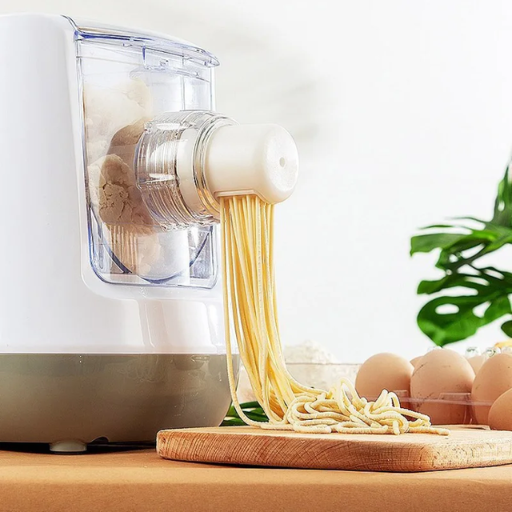We welcome you to our all-inclusive book on how to become an expert in homemade pasta with the help of an electric pasta maker. This guide is intended for any cook, whether a professional or just a beginner, who wants to make his or her pasta cooking less complicated but more enjoyable by all means. In this next segment, we will discuss the vital parts of an electric pasta maker and then provide detailed instructions for making perfect dough, share some tips about what can go wrong together with ways to fix it, and finally furnish you with great recipes that will be appropriate for your home kitchen. We are going to give you all the necessary information and motivation to enable you to prepare restaurant-standard pasta for your household. Let’s get started on this sumptuous adventure.
What Are the Best Pasta Makers for Beginners?
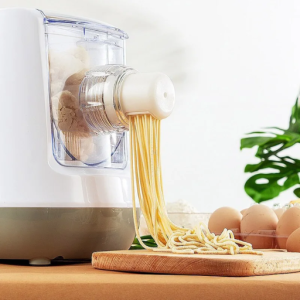
Image source: https://www.searchfindorder.com/
Some pasta makers are perfect for beginners: these include several models that combine ease of use, reliability, and value for money. The Philips Compact Pasta Maker is an excellent choice that offers convenience with its automated mixing, kneading, and extruding capabilities. Another good option is the Marcato Atlas Pasta Machine, which may not be as popular. Still, it has stood the test of time, provided one can get its separate motor attachment to make it automatic. People who want to spend less on a pasta maker while still learning how to use homemade pasta should consider Hamilton Beach Electric Pasta Maker. This is because all these machines provide good starting points for amateurs in pasta making.
How to Choose the Right Pasta Maker for Your Needs?
You need to consider several factors when selecting the right pasta maker. Firstly, consider whether you would rather have an electric or manual one. For example, the Philips Compact Pasta Maker is an electric model best suited for beginners since it has programmed settings, making the process easier. On the other hand, some fundamental users love to be in control and, therefore, prefer manual machines like the Marcato Atlas Pasta Machine. Still, they may require additional attachments for motorization. Secondly, examine the machine is versatility; some pasta makers have various accessories that can make different pasta shapes. Thirdly, check its cleaning and maintenance ease, as this will determine how often you use it. Lastly, go through reviews and ratings from other people who used it so that you can ensure that this particular brand or model will fit your requirements perfectly fine.
Best Pasta Makers for Home Use
Having analyzed top-rated content from popular sites, we have selected the best pasta makers for home use based on performance, simplicity, and dependability:
- Philips Pasta and Noodle Maker Plus: This electric model is celebrated for its powerful features and ease of use. It enables users to make all sorts of pasta shapes without much effort. It has unique stirring sticks and advanced extrusion technology, which ensure uniformity.
- Marcato Atlas 150 Pasta Machine: This hand-cranked device is highly regarded for its craftsmanship and long-lasting nature, which creates a traditional pasta-making experience. With adjustable settings and optional motor attachments, it offers excellent control over the process and the adaptability needed by both beginners and seasoned chefs.
- Hamilton Beach Electric Pasta and Noodle Maker: This inexpensive electric model is noted for being fundamental yet practical. It can be used simply by pressing buttons for automatic mixing, kneading, and pushing out; it makes homemade pasta affordable even for those who don’t know how to cook.
These selections cater to the different needs of home cooks in their journey of making pasta.
Benefits of Using an Electric Pasta Maker
Using an electric pasta maker has several fundamental advantages that make the process of pasta making more straightforward and enjoyable. Firstly, they automate the whole process by doing tasks such as mixing, kneading, and extruding, hence reducing the time and energy required. This is especially good for pasta-making beginners or people with limited time to prepare food. Additionally, electrical pasta makers ensure that dough has a consistent texture and thickness, resulting in uniformly shaped paste every single time it’s made. They also come with different attachments, allowing one to create various sizes and shapes of pasta, ranging from spaghetti to lasagna sheets, mainly by changing the attachment. Finally, many electric pasta makers are designed with user-friendly features and are easy to clean, thus making them highly maintainable and motivating regular usage. All these benefits collectively improve the general experience of pasta-making, rendering it from a complex task into an interesting one.
How to Make Fresh Pasta with an Automatic Pasta Maker?
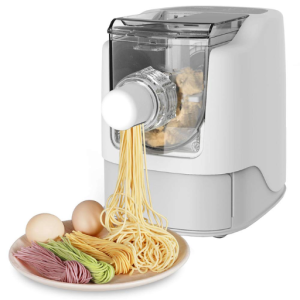
How to Make Fresh Pasta with an Automatic Pasta Maker
- Get ingredients ready: measure out flour and eggs, as indicated in the pasta maker’s handbook. Popular ratios include one cup of flour to one egg.
- Add Ingredients to the Machine: Transfer the flour into the pasta maker’s mixing area before adding eggs or any other liquid substances. In some machines, you could load in extra flavors at this point.
- Machine Setting: Choose the appropriate type of pasta and thickness setting. Refer to the manufacturer’s guide for instructions on how to make setting changes.
- Start the machine: Turn on the Pasta Maker and go. The machine mixes and kneads the dough automatically within a few minutes.
- Extrude Pasta: On completion, the dough will come out through a dedicated shape attachment for selecting the pasta. Cut your pasta into small bits using a knife or the provided cutter, which is built-in on this appliance.
- Dry or cook: Steam freshly extruded spaghetti immediately for around five minutes before drying if it will be used later after preservation.
Thus, you can easily make homemade fresh pasta with an automatic pasta maker.
Step-by-Step Guide to Using a Philips Pasta Maker
The use of Philip Pasta Maker in making fresh pasta is a simple and efficient process. See below the summarized procedure of this latest guide:
- Take Measurements: Ensure you have used these measuring cups for this purpose. The machine would typically require about 200g of flour and approximately 80 ml of liquid (either water, egg, or both).
- Put Flour into the Machine: Open the cover and pour the measured flour into the mixing compartment.
- Choose Type of Pasta: Choose your desired type of pasta by attaching a suitable disc to the machine.
- Begin Mixing: Cover it tightly and select your pasta’s type program so that it prompts you to add in liquid.
- Pouring Liquid Ingredients: Gradually pour this liquid via its specified aperture while this machine continuously blends & kneads dough.
- Extruding Pasta Out: At the right mixture, the dough is sucked out via an appropriate disk specified.
- Cutting and Drying Pasta: As it comes out, cut it into lengths you prefer, then place it on a drying rack or floured surface.
- Cooking Fresh Pasta: Boil salted water for 2-4 minutes instead of the longer time required for dry pasta. Check if the texture suits you.
With these few steps, anyone can quickly prepare different kinds of homemade fresh pasta using their Philips Pasta Maker.
Tips for Achieving Perfect Pasta Dough
- Use Quality Ingredients: Choose high-grade flour, such as 00 or semolina flour, and add fresh eggs or water for the best dough texture and taste.
- Appropriate Flour-to-Liquid Ratio: The important part of mixing pasta dough is maintaining the right balance between flour and liquid. One large egg to 100 grams of flour is recommended for most pasta. If using water, this will depend on the type of flour you have.
- Room Temperature Ingredients: Ensure all your ingredients are at room temperature for more consistent dough.
- Knead Fully: Knead your dough well to develop the gluten necessary for pasta’s elasticity and chewiness. Typically, by hand, it takes about ten minutes of kneading until the dough becomes smooth and elastic.
- Let Dough Rest: Cover the dough with either a damp cloth or plastic wrap and leave it to rest for at least 30 minutes. This break allows the gluten to relax and the moisture to distribute evenly, making rolling easy.
- Check Consistency: The mixture should be firm but not sticky. If it is too dry, sprinkle some water on it. For excessive wetness, add small amounts of flour until the desired consistency is achieved.
- Uniform Thickness: Strive for uniform thickness when rolling out the dough. Consequently, you will have uniformly cooked pasta with similar texture throughout.
-
Be Patient: Making pasta dough requires patience, so don’t get discouraged if it does not turn out perfect the first time; every try will help you adjust and improve your technique.
Common Mistakes to Avoid When Using an Electric Pasta Machine
- Flouring the Dough and Machine Properly: The most common mistake is not using enough flour, which can frustrately stick dough to rollers and cutters. Dust both lightly to ensure smooth operation.
- Feeding Too Much Dough at Once: Overloading the machine with a large quantity of dough causes uneven thicknesses and overworks the motor. Feed dough proportions into a machine that is easily handled for dependable outcomes without damaging it.
-
Skipping the Gradual Thickness Adjustment: Changing thickness settings gradually while preparing pasta will avoid dough tearing or unevenness. Set it at its widest position, then carefully reduce it one step at a time until you achieve your desired thickness; this will preserve your dough and help you get uniform pasta.
What Settings Should You Use on a Pasta and Noodle Maker for Different Pasta Shapes?
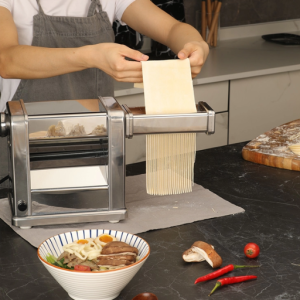
The settings used in a pasta and noodle maker are essential when achieving the desired pasta shapes and textures. The recommended settings for popular pasta shapes are as follows:
- Spaghetti and Linguine: Start at medium thickness and move gradually towards a thinner setting, which usually ranges from the third to the fourth notch, depending on your machine.
- Fettuccine and Tagliatelle: These types of noodles need thickness in more expansive proportions. Begin with the broadest one, then move to second or third notches for best results.
- Lasagna Sheets: When making lasagna, use the widest setting on your pasta gadget. This will ensure strong, flexible sheets that work well when layered.
- Ravioli: For filled pasta like ravioli, use a middle-thickness setting. This gives you a firm enough dough to hold the filling without being too thick.
- Penne and Macaroni: Most of these shapes require extrusion settings; therefore, you should check your machine’s manual for specific extrusion settings appropriate for such types of pasta, as they often involve different discs/ attachments
Following these instructions will help you have uniformly shaped, well-cooked pasta dishes every time you cook them.
How to Use Pasta Shaping Discs?
To produce pasta with your pasta shaping discs, you need a few steps, which I will outline below:
- Interconnect the Disc: Start by ensuring the disc you want to use is securely attached to your noodle maker or pasta machine. It should fit snugly so there will be no jiggling or wobbling during extrusion.
- Prepare the Dough: According to the machine’s recommendations, your dough should not be too wet or too dry. It is generally advisable to have a somewhat stiff but flexible dough.
- Dough Feeding into the Machine: Cut the prepared dough into small, manageable pieces and feed them through the machine’s hopper.
- Extrude Pasta: With your machine switched on, let it force out some amounts of the mixture through this shaping disc. As it leaves the machine, you may cut/trim your strings of pasta using a knife or cutter of any length you desire.
- Dry and Boil Instantly: Once shaped in various ways depending on its type, either place it on a rack for drying or cook immediately. Freshly extruded pasta cooks fast within a few minutes.
You can make consistently shaped pasta by doing this step and checking if your dough consistency is okay.
The Best Settings for Making Spaghetti, Lasagna, and More
The settings on your pasta machine are critical in making spaghetti, lasagna, and other pasta types. These are some of the best settings for popular pasta types:
- Spaghetti: Use a thin disc to make spaghetti with your pasta machine. The dough must be smooth and slightly dry. Extrusion speed should be adjusted to medium fast so that the dough can go through without clogging. Normally you would also want to set it at around 1.5-2 mm thick.
- Lasagna: A flat, wide disc is required for lasagna sheets. You should extrude your machine at slower speeds while adequately rolling out your dough. For firm lasagna sheets that hold well when baked, the thickness should be at the highest machine setting, usually about 2 mm.
- Fettuccine: To make fettuccine, select a fettuccine die with a medium thickness level. The dough has to be reasonably dry and cut perfectly, and the extrusion speed has to range between slowest and fastest. This will produce long, firm, textured pasta ribbons with good sauce retention properties.
Always consult the manual for your particular pasta machine model or brand, as settings may differ from one equipment type to another.
Adjusting Your Philips Pasta Maker for Perfect Results
To achieve perfect pasta from your Philips Pasta Maker, fine-tuning is necessary to ensure consistency and quality. Here are the most critical adjustments according to experts’ advice:
- Flour to Water Ratio: Begin by using 1 cup of flour for every 95 ml of water, with slight modifications due to humidity level or the type of pasta being made. Always mix it until it becomes crumbly before extruding.
- Kneading Time: Let the machine knead the dough as required in its manual, usually about three to five minutes. Adequate kneading is essential because gluten development determines the texture of good pasta.
- Extrusion Speed: Adjusting the extrusion speed may be necessary depending on the kind of pasta. Slower speeds should be chosen for more delicate pasta, like angel hair, so they do not break apart. Medium-fast speeds work best for harder pasta options like penne.
- Cleaning the Machine: To ensure smooth running and eliminate contamination, clean your machine regularly, particularly the extrusion discs and stirring rods.
These settings help you achieve optimal texture and taste, making each pasta batch a culinary masterpiece.
Why Choose a Manual vs. Automatic Pasta Maker?
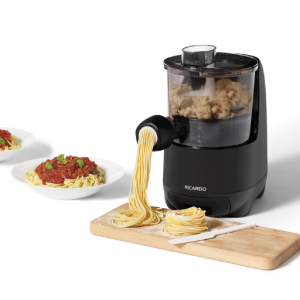
The choice between a manual and an automatic pasta maker depends on your preferences and needs in the kitchen. Traditionalists who want to cook their pasta hands-on have more control over the thickness and texture of noodles using a manual pasta maker. Furthermore, it tends to be less expensive than an automated one and does not need electricity; hence, it is environmentally friendly. Conversely, an automatic pasta maker is known for its ease-of-use feature and high speed; it mixes, kneads, and extrudes dough without any effort required from you. This model is best suited for people with a hectic schedule or who are just starting to make pasta but want reliable results without much work. Ultimately, this depends on whether you prefer getting involved manually or you want your cooking experience to be quite efficient during pasta making.
Pros and Cons of Manual Pasta Makers
Pros:
- Control over dough consistency: A manual pasta maker would let you feel the dough’s consistency and adjust it to be perfect in each batch.
- Thickness settings can be adjusted: Thus, they offer a wide range of thickness levels, which allows one to make different shapes and types of pasta.
- Cheaper prices: Manual models are generally more affordable than automatic ones, which encourages more people to start making their pasta at home.
- They Can Be Used Anywhere Without Electricity: They are eco-friendly and can be used anywhere, including places without electricity.
- Robust Construction: Mostly made from solid materials such as stainless steel that increase durability.
Cons:
- Manual Work: This requires hard manual labor, which can be tiring, especially when preparing large quantities.
- Takes a long time: It takes longer than auto-machines, which might not work well with busy schedules.
- Skills Required: There is a learning curve; the technique needs practice and patience before one masters it fully.
- Few Functions: Commonly, it only rolls and cuts, unlike other automatic ones that have some additional elements like kneading processes.
-
Cleaning Can Be More Difficult: Cleaning can take longer with many intricate parts and manual cranks.
Is an Automatic Pasta Maker Right for You?
Whether or not an automatic pasta machine would be appropriate for you depends on your lifestyle and the kind of pasta you want to make. If you put a premium on convenience and time, then an automated pasta maker may be the right choice. They handle kneading, rolling, and cutting the dough, saving much human effort. This can be useful mainly in cases where one has a lot of work to do or a physical disability. Also, the production lines are provided with numerous settings options that come with accessories while making various types and shapes of dough without much effort. However, they are likely to be costly and space-consuming for countertops. Lastly, suppose easy appliance use matters most, and it’s affordable to buy at a higher price than usual. In that case, an automatic pasta maker can improve your way of making pasta dishes.
Comparing Manual and Electric Pasta Makers
If you are choosing between an electric and a manual pasta maker, you have to pay attention to key differences in effort, time, versatility, and cost.
Effort: Manual pasta makers require a lot of energy to operate, which is why they are not good for people with physical disabilities or very busy schedules. On the other hand, electric pasta makers do most of the work, such as kneading, rolling, and cutting, thus reducing the human labor involved.
Time: Hand-operated machines may take a lot of time, especially when making large quantities. The electronic ones save time by making the whole process faster, which is important.
Versatility: When compared with manual models, electric pasta makers can be fitted with different settings and attachments, producing various types of pasta with distinct shapes and thicknesses. One can usually do little with a manually driven pasta shaper apart from rolling it out or slitting it into required ribbons, unlike electrically powered ones, which typically come with these additional features.
Cost: Manual versions are generally cheaper, but this comes at the cost of more labor and time. Electric machines are more expensive, but they provide the convenience of automation and fast production.
Maintenance: Assembling parts to clean them is what makes washing a manual pasta-making machine difficult because some parts are very intricate. Amongst other things, electrics often bear many components, though many of them allow easy disassembly, hence making them easy to clean.
Moreover, whether to purchase a mechanical or electrical spaghetti maker depends on individual priorities and lifestyle choices. So, if you appreciate traditionality and hands-on activities, this would be perfect for you. At the same time, if ease, convenience, and speed flexibility come first, then an electrical one will serve you best.
How to Care for and Maintain Your Pasta Machine?
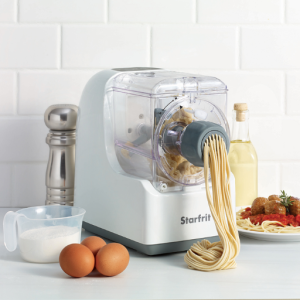
To maintain your pasta machine properly to achieve exemplary service and long life, the following concise points apply:
- Immediate Cleaning: Clean the machine immediately so the dough does not dry.
- Use a Brush or Cloth: Use a soft brush or cloth to eliminate dough scraps. Do not use water; do not immerse it as it may result in rust, especially for manual ones.
- Disassemble Carefully: Electric models should be disassembled and removable parts cleaned according to the manufacturer’s instructions.
- Lubricate Regularly: Apply food-safe mineral oil on moving elements occasionally so that they work smoothly.
- Store Properly: Keep it dry with no moisture and dust.
Adhering to these guidelines will ensure that your pasta machine continues to function well into the future; hence, you can make fresh homemade pasta anytime.
Cleaning Tips for Your Electric Pasta and Noodle Maker
Cleaning an electric pasta and noodle maker does not have to be a daunting task. Here are some expert tips that will help you keep your machine in great shape:
- Unplug and Allow to Cool: Ensure the machine is unplugged and has cooled down before embarking on the cleaning process.
- Take Apart and Soak Detachable Components: Disassemble all detachable components and soak them in warm, soapy water, which helps to loosen any dough residues.
- An Unyielding Dough Calls for a Brush: Use a soft brush to scrub and clean the parts gently with some remaining dough. Avoid using abrasive pads, as they may damage the surface.
- Clean the Main Unit: For non-removable parts and the main unit, wipe it off using a slightly damp cloth, removing flour or dough splinters.
- Allow Drying Completely: Before reassembling and putting back into storage, ensure that all pieces are completely dry to prevent rusting or mold.
- Observe Manufacturer’s Instructions: Always refer to the manufacturer’s guide on particular cleaning instructions and precautions, which, if ignored, could invalidate warranties.
By practicing these cleanliness tips, one can prolong the life of his/her electric pasta/noodle maker and enjoy perfectly made homemade pasta forever.
What to Do If Your Electric Pasta Maker Malfunctions?
1. Test the Power Connection: Make sure your pasta maker is plugged in correctly and the socket works. To eliminate any electrical concerns, you can try connecting it through another outlet.
2. Study the Instructions: Check the user manual for a remedy to your model’s problem. They often contain answers to common issues and guidelines on restarting the equipment.
3. Search for Clogs: Take apart the machine and ensure there is no dough or other matter blocking its operations. Quite often, complete cleansing of these elements assists in resolving operational faults.
4. Connect with Customer Care: If you cannot figure out what happened, talk to the customer care of the manufacturer. They will offer professional consultation and could help you with warranty repairs or spare parts.
5. Find Professional Repair Shops: If you are no longer under warranty or don’t know how to solve a problem, try getting it fixed by a specialist who repairs small kitchen appliances.
These steps will enable most electric pasta makers to troubleshoot some of the most typical problems that may occur and continue making homemade foods within minutes.
What Are Some Popular Recipes to Try with Your Electric Pasta Extruder?
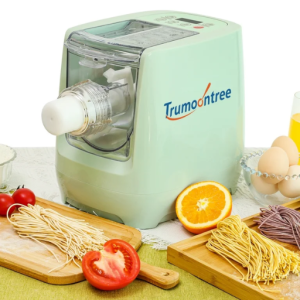
1. Classic spaghetti: This is suitable for beginners using an electric pasta extruder who are looking for the usual Italian dish. It can be either marinara or meat ragu.
2. Penne Arrabbiata: Penne Arrabbiata is known for its robust and spicy tomato sauce. Every bite tastes excellent because the hollow penne shape perfectly holds the sauce’s spiciness.
3. Fettuccine Alfredo: Many people like fettuccine alfredo because it is rich and creamy. The freshly extruded fettuccine and the cheesy, buttery sauce create a comforting meal.
4. Macaroni and Cheese: Freshly extruded macaroni will make this classic comfort food even better. A tender texture that goes perfectly with creamy cheese sauce is what fresh pasta has.
5. Lasagna: Making lasagna sheets using your pasta extruder, which consists of multiple layers of meat, cheese, and tomato sauce, is easy. New pasta sheets come in handy for a softer, more cohesive lasagna.
6. Bucatini All’Amatriciana: This recipe calls for Bucatini, a thick, spaghetti-like pasta with a hole running through it. It is served with rich tomato and pancetta sauce to complete one’s day.
You can experiment with these recipes to fully utilize your electric pasta extruder while enjoying delicious homemade meals.
Delicious Noodle Dishes for Every Occasion
1. Pad Thai: This popular Thai food is known worldwide for its harmony of sweet, salty, and sour sensations. It consists of rice noodles tossed with either shrimp or chicken and mixed vegetables, stir-fried in a tamarind sauce with peanuts and lime juice sprinkled on top.
2. Chicken Alfredo Pasta: This rich and creamy dish combines tender fettuccine pasta with a butter-and-cream alfredo sauce that grilled chicken and broccoli often accompany.
3. Pesto Pasta: The bright green pesto sauce is prepared using fresh basil leaves, garlic, Parmesan cheese, pine nuts, and olive oil before being mixed thoroughly with the boiled pasta. Pesto can also be served cold or hot, depending on your preference.
Incorporating these noodle dishes into your cooking repertoire will enable you to cater to various tastes and preferences when preparing for different formal or informal occasions.
Frequently Asked Questions (FAQs)
Q: What are the benefits of using an electric pasta maker?
A: An electric pasta maker simplifies making pasta at home, saving you time and effort. These machines often include features like a pasta roller, which ensures consistent thickness, and multiple attachments for different pasta types. Electric pasta makers like the Hamilton Beach Electric Pasta Maker also provide automated mixing and extruding, leading to fresher, tastier pasta.
Q: How does a pasta roller work in an electric pasta maker?
A: A pasta roller in an electric pasta maker helps flatten and roll out the dough to the desired thickness. This component ensures uniformity, making it easier to cut the dough into various shapes. Rolling the dough multiple times results in a smoother texture, essential for preparing high-quality, fresh pasta at home.
Q: Which features should I look for in the best electric pasta maker?
A: When choosing the best electric pasta maker, consider features like multiple pasta attachments, a compact design, and ease of use. Some top models, such as the Philips 7000 Series Pasta Maker, offer automated dough mixing and extruding, making the process faster and more efficient. Look for machines that allow for easy cleaning and have durable components for long-term use.
Q: Can kitchen aid attachments be used to make pasta?
A: There are specific KitchenAid pasta attachments designed for use with KitchenAid mixers. These attachments can roll, cut, and extrude pasta, making it convenient to prepare various types of pasta, noodles, and even ramen. Popular options include the KitchenAid pasta roller and other KitchenAid attachments for pasta noodle and ramen making.
Q: What makes the Hamilton Beach Electric Pasta Maker unique?
A: The Hamilton Beach Electric Pasta Maker stands out for its user-friendly design and consistent performance. It features multiple pasta maker attachments, allowing you to create various pasta shapes. The compact pasta design makes it easy to store, and the automated functions streamline the pasta-making process, making it suitable for beginners and seasoned chefs.
Q: How can I use an electric pasta maker at home?
A: To make pasta at home using an electric pasta maker, prepare the dough mixture according to your recipe. Load the dough into the pasta maker’s mixing compartment if it has one, or use a dough maker to mix it separately. Use the pasta roller to roll the dough to your desired thickness and attach the necessary pasta-maker attachment to cut or shape the pasta. Finally, cook the fresh pasta in boiling water until tender.
Q: What types of pasta can be made with a pasta maker machine?
A: A pasta maker machine can make various pasta types, including fettuccine, spaghetti, lasagna sheets, and linguine. Additional attachments may allow for the creation of specialty noodles like ramen and more complex shapes. Machines like the Philips 7000 Series Pasta Maker and various KitchenAid pasta attachments offer versatile options for different pasta styles.
Q: Is a compact pasta and noodle maker suitable for small kitchens?
A: A compact pasta and noodle maker is designed to fit conveniently in small kitchens without sacrificing functionality. These machines are perfect for those with limited counter space who want to enjoy homemade pasta. Compact models like the Hamilton Beach Electric Pasta Maker offer storage-friendly designs and efficient performance.
Q: How do I clean a pasta maker attachment?
A: Cleaning a pasta maker attachment typically involves disassembling the parts and using a soft brush or a toothbrush to remove dough residues. Some parts may be dishwasher safe, but it’s essential to consult the manufacturer’s instructions. Proper cleaning ensures the longevity and hygiene of your pasta maker attachment, whether for KitchenAid or other brands.
Q: Can I make pasta without an electric extruder?
A: Yes, making pasta without an electric extruder is possible using a manual pasta maker or even by hand. Manual pasta rollers and cutters can help achieve desirable pasta shapes and thicknesses. However, electric extruders streamline the process and ensure consistent results, making it easier and faster to produce homemade pasta.












